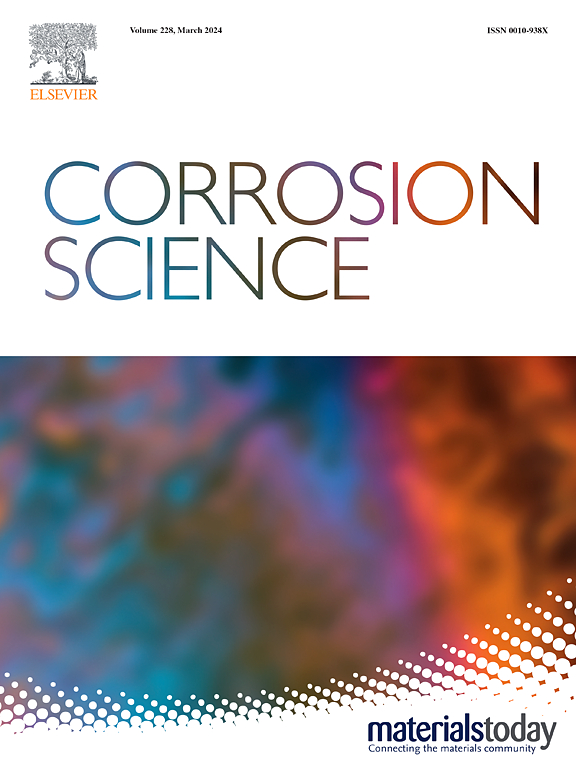Formation mechanism of Zr-based conversion coating on 6061-T6 Al and C1100 Cu galvanic couple
IF 7.4
1区 材料科学
Q1 MATERIALS SCIENCE, MULTIDISCIPLINARY
引用次数: 0
Abstract
Friction stir welding is a solid-state method for joining similar or dissimilar metals. Dissimilar weldments are susceptible to galvanic corrosion, signifying the need for surface treatment. The feasibility of forming a continuous ZrO2 conversion coating on 6061-T6 Al/C1100 Cu dissimilar weldments in a ZrF62- solution was studied, focusing on the macro-galvanic coupling effect. C1100 Cu did not undergo a conversion coating reaction in the ZrF62- solution at pH 4. However, the conversion reaction proceeded when coupled to 6061-T6 Al. In contrast, the conversion coating reactions prevailed on 6061-T6 Al with and without coupling to C1100 Cu. The microstructure of the stir zone of 6061-T6 Al/C1100 Cu dissimilar weldments is highly heterogeneous. Micro-galvanic corrosion prevailed in the ZrF62- solution, and the resulting ZrO2 conversion coating contained many cracks. In contrast, a sound conversion coating formed on the 6061-T6 Al/C1100 Cu dissimilar weldments because the macro-galvanic coupling between 6061-T6 Al and C1100 Cu base metals compensated the micro-galvanic effect in the stir zone. These results corroborate that a rise in pH is necessary to trigger the dissociation of ZrF62-. Thus, Zr conversion coating is feasible for Al and Cu dissimilar weldments.
6061-T6 Al和C1100 Cu电偶zr基转换涂层的形成机理
搅拌摩擦焊是一种连接相似或不同金属的固态方法。不同的焊接件容易受到电偶腐蚀,这表明需要进行表面处理。研究了在ZrF62溶液中在6061-T6 Al/C1100 Cu异种焊件上形成连续ZrO2转换涂层的可行性,重点研究了宏观电偶效应。C1100 Cu在pH为4的ZrF62溶液中未发生转化包覆反应。而与6061-T6 Al偶联时,转化反应仍在继续。与C1100 Cu偶联和未偶联时,6061-T6 Al均发生了转化涂层反应。6061-T6 Al/C1100 Cu异种焊件搅拌区组织高度不均匀。微电偶腐蚀在ZrF62溶液中普遍存在,形成的ZrO2转化层存在许多裂纹。相反,6061-T6 Al/C1100 Cu异种焊缝上形成了良好的转化层,这是因为6061-T6 Al与C1100 Cu母材之间的宏观电偶补偿了搅拌区的微观电偶效应。这些结果证实了pH的升高是触发ZrF62-解离的必要条件。因此,Zr转化涂层在铝、铜异种焊件上是可行的。
本文章由计算机程序翻译,如有差异,请以英文原文为准。
求助全文
约1分钟内获得全文
求助全文
来源期刊

Corrosion Science
工程技术-材料科学:综合
CiteScore
13.60
自引率
18.10%
发文量
763
审稿时长
46 days
期刊介绍:
Corrosion occurrence and its practical control encompass a vast array of scientific knowledge. Corrosion Science endeavors to serve as the conduit for the exchange of ideas, developments, and research across all facets of this field, encompassing both metallic and non-metallic corrosion. The scope of this international journal is broad and inclusive. Published papers span from highly theoretical inquiries to essentially practical applications, covering diverse areas such as high-temperature oxidation, passivity, anodic oxidation, biochemical corrosion, stress corrosion cracking, and corrosion control mechanisms and methodologies.
This journal publishes original papers and critical reviews across the spectrum of pure and applied corrosion, material degradation, and surface science and engineering. It serves as a crucial link connecting metallurgists, materials scientists, and researchers investigating corrosion and degradation phenomena. Join us in advancing knowledge and understanding in the vital field of corrosion science.
 求助内容:
求助内容: 应助结果提醒方式:
应助结果提醒方式:


